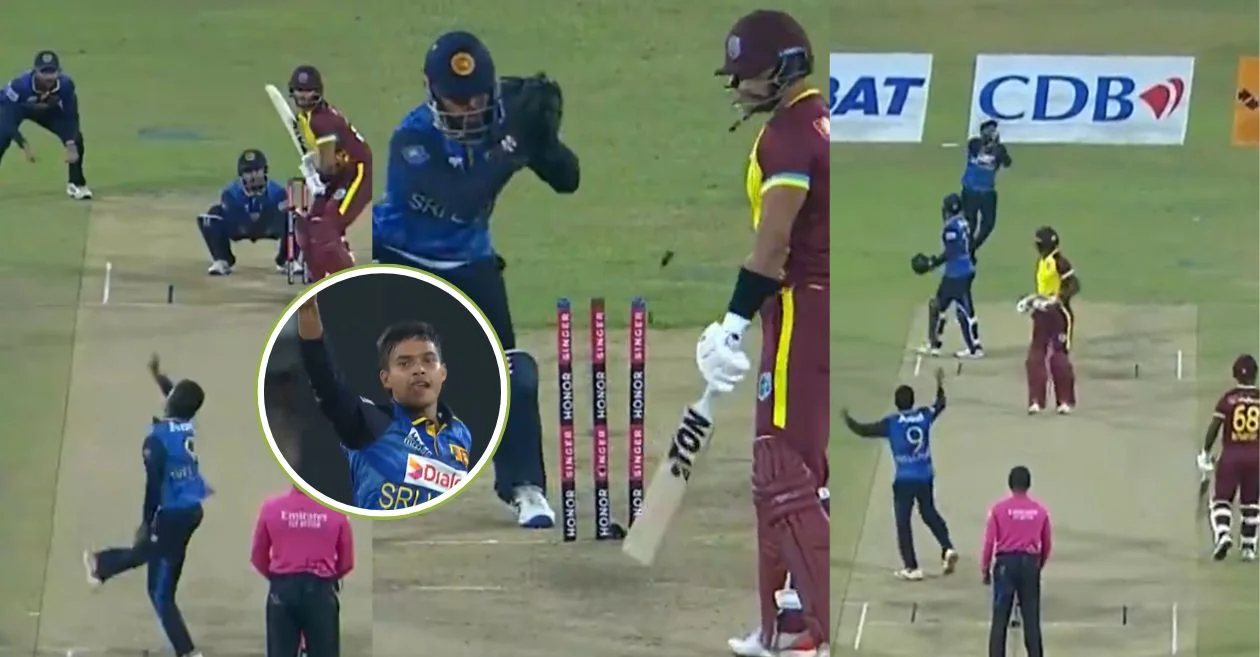Sri Lanka stormed back in style to level the T20I series against the West Indies with a resounding 73-run win in the second match held at Dambulla on Tuesday (October 15). In a match where the bowlers stole the spotlight, debutant Dunith Wellalage delivered a spectacular performance that left the West Indian batting lineup in shambles. The 20-year-old’s introduction to international T20 cricket could not have been more memorable, as he played a pivotal role in Sri Lanka’s commanding win.
With Sri Lanka’s spinners dominating the proceedings, Wellalage found strong support from seasoned bowlers Maheesh Theekshana, Wanindu Hasaranga, and Charith Asalanka. Together, the spin quartet orchestrated a devastating collapse of the West Indian batting order, limiting them to just 89 all out in response to Sri Lanka’s total of 162/5. The emphatic victory not only showcased Sri Lanka’s spin prowess but also demonstrated their resilience in bouncing back from a tough first match defeat to level the series.
Dunith Wellalage’s Dream Debut: A Spin Masterclass
Dunith Wellalage, on his T20I debut, delivered a performance that will long be remembered. His stunning spell of 3 wickets for just 9 runs in 4 overs dismantled the West Indian top order and set the tone for Sri Lanka’s dominance. Wellalage’s control, variation, and confidence were on full display as he spun a web around the West Indies batters, leaving them clueless on a turning pitch at Dambulla.
The young spinner’s first international wicket came in the form of a well-set Brandon King, who charged down the wicket only to be deceived by Wellalage’s subtle variation in length. The ball was held back just enough to leave King stranded, allowing Kusal Mendis to complete an easy stumping. Wellalage followed this up with the dismissals of Andre Fletcher and Roston Chase, both of whom fell victim to his flight and guile. Fletcher, attempting an aggressive sweep, could only manage a top edge, which was comfortably caught by Kamindu Mendis, while Chase nicked a sharply dipping delivery to slip.
Wellalage’s dream debut has immediately cemented his place as a key spinner for Sri Lanka in the future, and his performance will give the team confidence as they continue to build towards the next set of international fixtures.
Sri Lanka’s Spin Quartet: Theekshana, Hasaranga, and Asalanka Shine
While Dunith Wellalage was the star of the show, Sri Lanka’s experienced spinners also played crucial roles in securing the victory. Maheesh Theekshana and Wanindu Hasaranga, both renowned for their accuracy and variations, continued to trouble the West Indies throughout their innings. The duo claimed two wickets each, adding to the pressure that Wellalage had already built.
Theekshana, in particular, was a model of consistency, using his clever changes in pace and trajectory to keep the West Indian batters guessing. His ability to bowl in the powerplay and restrict runs early on set the tone for Sri Lanka’s defense of their total. Hasaranga, meanwhile, once again proved why he is considered one of the best limited-overs spinners in the world, mixing his googlies and leg breaks to perfection.
Charith Asalanka also chipped in with a crucial wicket, completing the spin quartet that dismantled the West Indies lineup. The relentless pressure from all four spinners left the West Indian batters with no room to breathe, as wickets fell at regular intervals and runs dried up.
West Indies’ Batting Collapse: No Answers to Sri Lanka’s Spin
The West Indies, chasing a target of 163, collapsed under the weight of Sri Lanka’s spin attack. Despite boasting a lineup full of explosive T20 talent, the visitors could not find a way to combat the relentless pressure applied by the Sri Lankan bowlers. The opening pair of Brandon King and Johnson Charles struggled to get going, with both falling cheaply, and the middle order fared no better.
Andre Fletcher, Nicholas Pooran, and Roston Chase were all dismissed without making any significant contributions, leaving the West Indies in tatters at 47/5. The collapse continued as the lower order failed to provide any resistance, with the entire team bundled out for just 89 runs in 16.1 overs.
West Indies’ inability to handle Sri Lanka’s spinners was a stark contrast to their performance in the first match of the series, where they had chased down a target with relative ease. The sudden shift in momentum in the second match highlights the unpredictable nature of T20 cricket and the importance of adapting to different conditions.
Pathum Nissanka and Kusal Perera Anchor Sri Lanka’s Innings
Earlier in the match, Sri Lanka posted a competitive total of 162/5, thanks largely to a composed innings from opener Pathum Nissanka, who top-scored with 54 runs. Nissanka’s patient knock provided the stability that Sri Lanka needed after losing early wickets, allowing the middle order to build around him. His ability to rotate the strike and find gaps in the field kept the scoreboard ticking and prevented the West Indies from building pressure.
Kusal Perera played a valuable supporting role, contributing a brisk 24 off 15 balls, while Dhananjaya de Silva (28) and Sadeera Samarawickrama (20*) added useful runs in the middle overs. The Sri Lankan batters showed great maturity in adapting to the slow, turning pitch, playing risk-free cricket while capitalizing on loose deliveries.
Although Sri Lanka’s total was not overwhelming, it proved to be more than enough, as their bowlers took full advantage of the conditions to defend the score comfortably.
Sri Lanka’s Fielding: A Key Factor in the Victory
In addition to their bowling, Sri Lanka’s fielding played a crucial role in the victory. The team was sharp in the field, with Kusal Mendis standing out behind the stumps. His quick reflexes were on full display during the stumping of Brandon King, while Kamindu Mendis took a smart catch at slip to remove Andre Fletcher.
Sri Lanka’s outfielders were equally impressive, cutting off boundaries and applying pressure on the West Indian batters by restricting their ability to rotate the strike. The collective fielding effort added to the West Indies’ frustration, as they found it difficult to build any momentum throughout their innings.
Sri Lanka’s commitment and energy in the field were reflective of a team determined to bounce back from their defeat in the first match, and their efforts were rewarded with a comprehensive victory.
What Lies Ahead: Deciding the Series in the Final Match
With the series now tied at 1-1, the third and final T20I promises to be a thrilling contest. Both teams have shown their strengths in different aspects of the game, and the decider will likely come down to which side can handle the pressure better. For Sri Lanka, their spinners will once again be key, while the West Indies will need to find a way to counter the spin threat if they are to win the series.
The momentum is now with Sri Lanka after their dominant performance in the second match, but the West Indies are a dangerous side capable of bouncing back quickly. The final match will be a true test of character for both teams, with pride and bragging rights on the line.
Sri Lanka’s Spin Magic Sets the Stage for a Gripping Finale
Sri Lanka’s 73-run victory in the second T20I was a testament to the power of spin bowling in T20 cricket. Dunith Wellalage’s sensational debut, combined with the experience of Theekshana, Hasaranga, and Asalanka, proved too much for the West Indies, who were unable to cope with the relentless pressure. With the series now level, the stage is set for a thrilling finale as both teams vie for the series win.
As the T20I series heads to its climax, cricket fans can look forward to one more enthralling encounter between two teams that have provided plenty of entertainment so far. Sri Lanka’s spinners will once again be at the forefront, while the West Indies will be looking to regroup and find a way to turn the tide in their favor.
Please check for information on the best betting sites in India – https://selectory.org/best-betting-sites/















